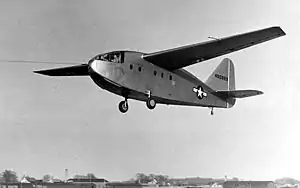Chase YCG-14
The Chase CG-14, also known as the G-14 or Model MS.1, was an assault glider manufactured by Chase Aircraft for the United States Army Air Forces during the Second World War. The aircraft failed to progress beyond the prototype stage, being overtaken by larger, improved glider designs.
| YCG-14 | |
|---|---|
 | |
| Role | Assault glider |
| Manufacturer | Chase Aircraft |
| Designer | Michael Stroukoff |
| First flight | January 4, 1945 |
| Primary user | United States Air Force |
| Produced | 3 |
| Developed into | Chase CG-18 |
Design and development
The first aircraft to be developed by Chase after its founding in 1943, the CG-14 was developed in preference to the Laister-Kauffman CG-10.[1] Constructed from marine-grade mahogany, as spruce was being used by the war effort in higher priority projects,[2] the XG-14 featured improved crash protection when compared to preceding gliders.[3]
Operational history
The XCG-14 made its maiden flight on January 4, 1945,[4] and following successful flight trials the aircraft was developed into two improved versions, the wood-and-metal XCG-14A[5] and the enlarged YCG-14A.[6]
The CG-14 was one of the few glider projects to be continued after the end of the war; however, it was quickly superseded by an improved aircraft, the XCG-18.[6]
Variants
- Chase MS.1
- Company designation for the XCG-14
- XCG-14
- First prototype, all-wooden.[5] 16 seats.[4]
- XCG-14A
- Wood and metal version of XCG-14.[5] 24 seats.[4]
- YCG-14A/YG-14A
- Production prototype version of XCG-14A, superseded by XCG-14B.[6]
- Chase MS.7
- Company designation for the XCG-14B
- XCG-14B/XG-14B
- Enlarged, improved variant, redesignated XCG-18, 2 built.[6]
Specifications (XCG-14)
Data from Fighting Gliders of World War II[7]
General characteristics
- Crew: 2
- Capacity:
- One 1-ton 4 x 4 truck + 3 soldiers or
- One M3A1 75 mm howitzer + crew or
- 18 troops fully equipped
- Length: 42 ft 10.5 in (13.069 m)
- Wingspan: 71 ft 9.6 in (21.885 m)
- Height: 6 ft 9.6 in (2.073 m)
- Wing area: 507 sq ft (47.1 m2)
- Aspect ratio: 10.18
- Airfoil: NACA 23016[8]
- Empty weight: 3,237 lb (1,468 kg)
- Max takeoff weight: 7,605 lb (3,450 kg)
Performance
- Maximum speed: 170 mph (270 km/h, 150 kn) Maximum Aero-tow speed
- Stall speed: 60 mph (97 km/h, 52 kn) flaps down
- Never exceed speed: 200 mph (320 km/h, 170 kn)
References
- Notes
- Bangash p.252.
- Visschedijk 2009
- Air Force Association. Air Force Magazine, volume 32, p.24.
- Jane 1948
- Flying magazine, Vols. 48-49, p.48
- Mitchell 1992, p.164.
- MRAZEK, JAMES E. (1 January 1977). Fighting Gliders of World War II (1st ed.). LONDON: St. Martin's Press. ISBN 0312289278.
- Lednicer 2010
- Bibliography
- MRAZEK, JAMES E. (1 January 1977). Fighting Gliders of World War II (1st ed.). LONDON: St. Martin's Press. ISBN 0312289278.
- Bangash, M.Y.H. (2009). Shock, Impact and Explosion: Structural Analysis and Design. London: Springer Verlag. ISBN 978-3-540-77067-1.
- Jane, Fred T. (1948). Jane's All The World's Aircraft. London: Franklin Watts.
- Lednicer, David (2010). "The Incomplete Guide to Airfoil Usage". University of Illinois at Urbana-Champaign. Archived from the original on 2010-04-20. Retrieved 2010-11-27.
- Mitchell, Kent A. (1992). "The C-123 Provider". AAHS Journal. Santa Ana, CA: American Aviation Historical Society. 37. Retrieved 2010-11-28.
- Visschedijk, Johan (2009). "Chase / Stroukoff". 1000aircraftphotos.com. Retrieved 2010-11-26.